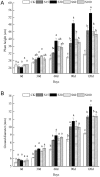Municipal sewage sludge compost promotes Mangifera persiciforma tree growth with no risk of heavy metal contamination of soil
- PMID: 29042679
- PMCID: PMC5645417
- DOI: 10.1038/s41598-017-13895-y
Municipal sewage sludge compost promotes Mangifera persiciforma tree growth with no risk of heavy metal contamination of soil
Abstract
Application of sewage sludge compost (SSC) as a fertilizer on landscaping provides a potential way for the effective disposal of sludge. However, the response of landscape trees to SSC application and the impacts of heavy metals from SSC on soil are poorly understood. We conducted a pot experiment to investigate the effects of SSC addition on Mangifera persiciforma growth and quantified its uptake of heavy metals from SSC by setting five treatments with mass ratios of SSC to lateritic soil as 0%:100% (CK), 15%:85% (S15), 30%:70% (S30), 60%:40% (S60), and 100%:0% (S100). As expected, the fertility and heavy metal concentrations (Cu, Zn, Pb and Cd) in substrate significantly increased with SSC addition. The best performance in terms of plant height, ground diameter, biomass and N, P, K uptake were found in S30, implying a reasonable amount of SSC could benefit the growth of M. persiciforma. The concentrations of Cu, Pb and Cd in S30 were insignificantly different from CK after harvest, indicating that M. persiciforma reduced the risk of heavy metal contamination of soil arising from SSC application. This study suggests that a reasonable rate of SSC addition can enhance M. persiciforma growth without causing the contamination of landscaping soil by heavy metals.
Conflict of interest statement
The authors declare that they have no competing interests.
Figures




Similar articles
-
Effects of landscape plant species and concentration of sewage sludge compost on plant growth, nutrient uptake, and heavy metal removal.Environ Sci Pollut Res Int. 2018 Dec;25(35):35184-35199. doi: 10.1007/s11356-018-3416-x. Epub 2018 Oct 17. Environ Sci Pollut Res Int. 2018. PMID: 30334137
-
[Effects of Continuous Application of Sewage Sludge Compost on Heavy Metals Accumulation and Mobility Characteristics in Soil Profile and on Heavy Metals Uptake of Wheat].Huan Jing Ke Xue. 2017 Feb 8;38(2):815-824. doi: 10.13227/j.hjkx.201608031. Huan Jing Ke Xue. 2017. PMID: 29964542 Chinese.
-
[Effects of sewage sludge compost on the growth and element uptake of Neolamarckia cadamba seedlings].Ying Yong Sheng Tai Xue Bao. 2017 May 18;28(5):1550-1556. doi: 10.13287/j.1001-9332.201705.036. Ying Yong Sheng Tai Xue Bao. 2017. PMID: 29745191 Chinese.
-
A critical review of the bioavailability and impacts of heavy metals in municipal solid waste composts compared to sewage sludge.Environ Int. 2009 Jan;35(1):142-56. doi: 10.1016/j.envint.2008.06.009. Epub 2008 Aug 8. Environ Int. 2009. PMID: 18691760 Review.
-
Effect of the direct use of biomass in agricultural soil on heavy metals __ activation or immobilization?Environ Pollut. 2021 Mar 1;272:115989. doi: 10.1016/j.envpol.2020.115989. Epub 2020 Nov 3. Environ Pollut. 2021. PMID: 33190985 Review.
Cited by
-
Effects of woodland slope on heavy metal migration via surface runoff, interflow, and sediments in sewage sludge application.Sci Rep. 2024 Jun 12;14(1):13468. doi: 10.1038/s41598-024-64163-9. Sci Rep. 2024. PMID: 38867064 Free PMC article.
-
Feasibility of Biochar Derived from Sewage Sludge to Promote Sustainable Agriculture and Mitigate GHG Emissions-A Review.Int J Environ Res Public Health. 2022 Oct 10;19(19):12983. doi: 10.3390/ijerph191912983. Int J Environ Res Public Health. 2022. PMID: 36232283 Free PMC article. Review.
-
Application of thermally treated sludge residues on an e-waste contaminated soil: effects on PTE bioavailability, soil physicochemical and biological properties, and L. perenne growth.Environ Sci Pollut Res Int. 2024 Mar;31(14):21962-21972. doi: 10.1007/s11356-024-32179-3. Epub 2024 Feb 24. Environ Sci Pollut Res Int. 2024. PMID: 38400963
-
Feasible and effective reuse of municipal sludge for vegetation restoration: physiochemical characteristics and microbial diversity.Sci Rep. 2019 Jan 29;9(1):879. doi: 10.1038/s41598-018-37338-4. Sci Rep. 2019. PMID: 30696901 Free PMC article.
-
Effects of landscape plant species and concentration of sewage sludge compost on plant growth, nutrient uptake, and heavy metal removal.Environ Sci Pollut Res Int. 2018 Dec;25(35):35184-35199. doi: 10.1007/s11356-018-3416-x. Epub 2018 Oct 17. Environ Sci Pollut Res Int. 2018. PMID: 30334137
References
-
- Yue Y, Yao Y, Lin Q, Li G, Zhao X. The change of heavy metals fractions during hydrochar decomposition in soils amended with different municipal sewage sludge hydrochars. J. Soil. Sediment. 2017;17:763–770. doi: 10.1007/s11368-015-1312-2. - DOI
Publication types
MeSH terms
Substances
LinkOut - more resources
Full Text Sources
Other Literature Sources
Research Materials

